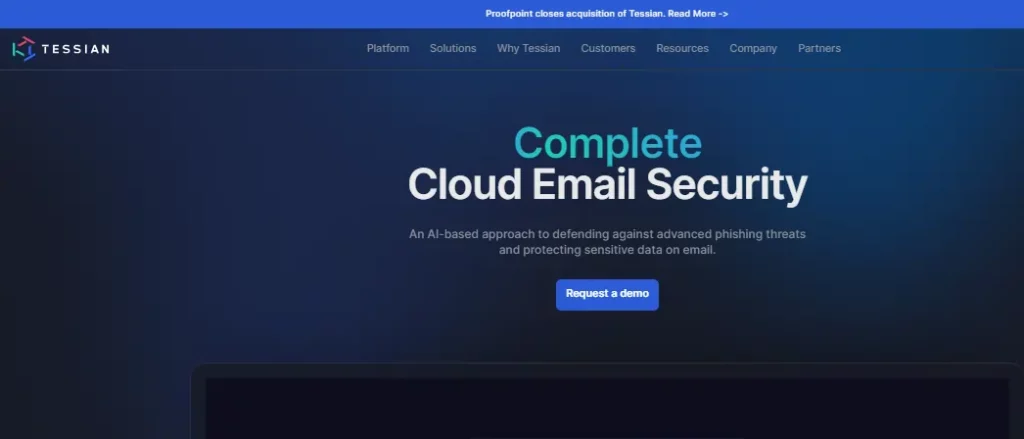DarkTrace

Vectra AI

SentinelOne

As cyber threats become increasingly advanced with sophisticated hacking tools powered by artificial intelligence, organizations need to fight back with AI-driven security tools. According to MarketsandMarkets, the AI security solution market will reach a value of over $46 billion by 2027 as more businesses adopt AI security platforms.
But with dozens of tools now leveraging machine learning and automation for threat prevention, detection, and response, how do you select the right one for your needs?
This guide examines 14+ top AI security tools that automate threat prevention, simplify audits, and accelerate incident response. If you are looking to upgrade legacy antivirus, improve threat hunting, or make overworked security teams more efficient, this guide explores the capabilities, pricing, integrations, and key differences between the top-rated options.
Read on to find which AI security tool is the best fit to protect your organization in 2024 and beyond.
What is an AI Security Tool and How Does it Work?
An AI security tool refers to a software solution that utilizes artificial intelligence (AI) and machine learning algorithms to automate various aspects of cybersecurity. Unlike traditional security solutions that rely on rules and signatures to detect threats, AI security tools analyze large volumes of data to identify patterns and anomalies indicative of malicious activity.
AI security tools typically work by first collecting data from different sources across an organization’s infrastructure, such as network traffic, endpoint activity logs, anomalies in user behavior, etc. This data acts as input which is fed into machine learning models. These models have been pre-trained to baseline normal activity and detect outliers. By continuously analyzing new data and learning from it, the accuracy of the AI models improves over time.
Once a threat is identified by the AI security tool, it can trigger automated responses and alerts for security teams. For example, suspicious traffic from a compromised endpoint could automatically be blocked while analysts are notified to investigate. The tool can also provide additional context and recommended actions to remediate threats. By combining advanced analytics, automation, and learning capabilities, AI-powered cybersecurity solutions enable organizations to respond to threats faster and enhance their cyber defenses.
The core benefit of AI security tools is the ability to rapidly uncover threats and security gaps that traditional systems often miss. They serve as a strength multiplier for security teams by reducing manual tasks, while providing proactive threat-hunting capabilities. Leading AI security tools on the market today include Darktrace, Vectra AI, and Cynet.
Key Features to Look for in AI Security Tools
AI security tools are becoming increasingly crucial in the cybersecurity landscape, offering advanced capabilities to detect and respond to threats in real-time. Here are some key features to look for when selecting an AI security tool:
Remember, the effectiveness of an AI security tool largely depends on its ability to adapt to new threats, analyze vast amounts of data in real-time, and provide valuable insights into potential security incidents.
List of Top AI Security Tools in 2024
Let us now take a look at the industry-leading AI security tools and platforms that are reshaping cybersecurity through automation and intelligent threat detection.
| AI Security Tools | USP | Pricing |
|---|---|---|
| 1. Darktrace | Autonomous response technology that interrupts cyber-attacks in real-time | 4.6/5 (Gartner) |
| 2. Vectra AI | Reveals and prioritizes potential attacks using network metadata | 4.7/5 (Gartner) |
| 3. SentinelOne | Fully autonomous cybersecurity powered by AI | 4.8/5 (Gartner) |
| 4. Cynet | Integrates XDR attack prevention and detection with automated investigation and remediation | 4.7/5 (G2) |
| 5. SparkCognition | Offer AI products that detect anomalies and assist cybersecurity teams. | 3.0/5 (Gartner) |
| 6. CloudSEK | Cloud-based security powered by AI and ML | 4.7/5 (Gartner) |
| 7. IronNet | Behavioral analysis for network threat detection | 4.4/5 (Gartner) |
| 8. Cylance | AI-driven endpoint security and threat prevention | 4.2/5 (G2) |
| 9. Balbix | Quantifies cyber risk using AI and predictive analytics | 4.8/5 (Gartner) |
| 10. CyberRiskAI | Provides a platform that quantifies cyber risk in financial terms | N/A |
| 11. Deep Instinct | Uses deep learning technologies to predict, prevent, and analyze cyber threats | 4.3/5 (G2) |
| 12. Tessian | Uses machine learning to secure enterprise mail | 4.6/5 (Gartner) |
| 13. CrowdStrike | Provides cloud-native endpoint protection platform built to stop breaches | 4.8/5 (Gartner) |
| 14. Sophos | Offers synchronized security: coordinated defense against cyber threats | 4.7/5 (Gartner) |
| 15. Dataminr | Real-time threat alerts leveraging AI and public data | 4.5/5 (G2) |
1. Darktrace
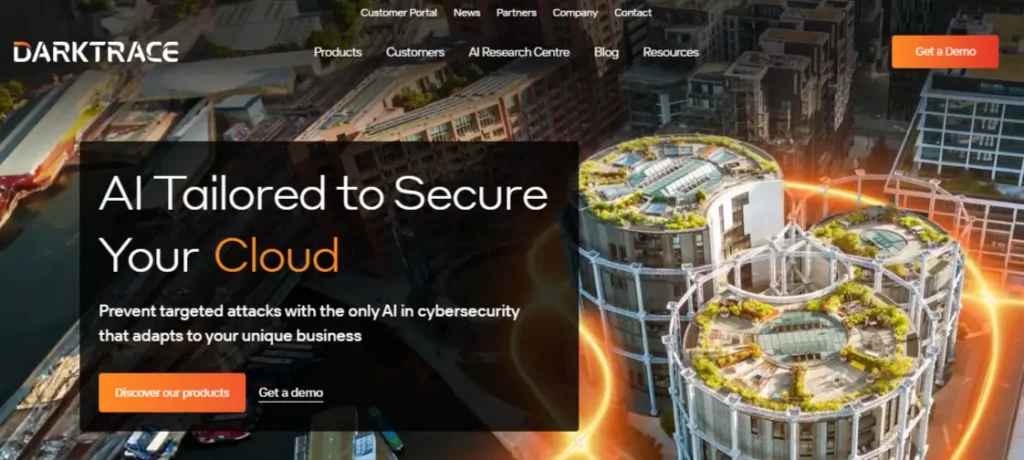
Darktrace is a global leader in cyber-AI security, founded in 2013 by mathematicians and cyber defense experts. Headquartered in Cambridge, UK, Darktrace protects over 9,000 customers across 110 countries from advanced cyber threats.
Darktrace is one of the fastest-growing cybersecurity companies, with an innovative AI research center developing new cyber defense technologies backed by over 145 patents. Its autonomous cyber defense platform uses self-learning AI to detect novel attacks and insider threats. Powered by enterprise-immune system technology, Darktrace products provide cyber threat visibility, detection, autonomous response, and risk management across cloud, SaaS, network, IoT, and industrial control systems.
Darktrace has received numerous awards, including being named one of TIME magazine’s “Most Influential Companies” in 2021. Trusted by leading companies and governments worldwide, Darktrace technology autonomously detects and responds to cyber-attacks in real time.
What does Darktrace do?
Darktrace uses artificial intelligence to detect and respond to advanced cyber threats across an organization’s digital infrastructure, including cloud, network, IoT, industrial control systems, and SaaS environments. Its self-learning AI analyzes data patterns to establish a ‘pattern of life’ specific to each customer and identify emerging anomalies that could signal cyber threats.
Darktrace autonomously responds to in-progress attacks at machine speed with surgical precision to neutralize threats. It also provides cyber risk management by continuously validating controls, proactively searching for vulnerabilities, emulating attacks, and prioritizing risks. The Threat Visualizer dashboard gives security teams full visibility while investigation tools empower analysts to conduct rapid incident response.
Key Features of Darktrace
1. Self-Learning AI
Darktrace’s self-learning AI forms a unique understanding of normal activity patterns across an organization’s entire digital infrastructure, including cloud, SaaS, network, IoT, industrial control systems, and email.
It does this by analyzing data flows to establish a customized model of ‘normal’ for that specific customer environment and workforce behaviors. This allows it to detect the subtlest anomalies indicative of emerging cyber threats, including never-before-seen attacks. The AI requires no rules, signatures, or prior threat knowledge to detect threats. It is constantly evolving to identify new attack patterns and techniques.
2. Autonomous Response
Darktrace Antigena allows for surgical, targeted responses to neutralize in-progress threats within seconds. Organizations can enable it to take intelligent action autonomously or choose to remain in oversight mode with human confirmation.
Antigena only interrupts the threat activity, allowing normal business functions to continue unaffected. It can surgically quarantine specific devices, lock user accounts, or shut down processes – all while avoiding unnecessary disruption. This enables a rapid, measured, and highly targeted response to threats at machine speed.
3. Unified Enterprise Coverage
Darktrace provides visibility, threat detection, and autonomous response across the full range of environments comprising today’s digital infrastructure. Its AI correlates anomalies and threats across these environments to reveal sophisticated attacks spanning multiple vectors. Full enterprise coverage allows Darktrace to establish contextual understanding and more accurately distinguish threats from normal activity.
4. Cyber Risk Management
In addition to real-time threat detection and response, Darktrace also provides continuous validation of security controls, vulnerability assessments, attack simulations, and prioritized recommendations – all powered by its AI. This allows organizations to constantly strengthen their cyber risk posture by hardening defenses, upgrading vulnerable software, enforcing least privilege policies, and taking proactive measures to prevent threats. Risks can also be prioritized based on vulnerability assessments mapped to the MITRE ATT&CK framework.
5. Investigation Tools
Darktrace equips analysts with investigation tools that allow for rapid and targeted response. The Threat Visualizer provides a unified overview of the digital business with full context on emerging threats. Analysts can then drill down to perform root cause analysis, review impacted devices, identify patient zero, visualize the lateral movement, and more.
The investigation is enhanced by explainable AI indicators highlighting the most relevant entities and anomalies driving a threat score. These tools combined with autonomous response allow security teams to neutralize threats faster.
- Detects novel, sophisticated, and stealthy attacks that other tools may miss
- Neutralizes threats autonomously at machine speed
- Easy to deploy across complex digital environments
- Provides visibility and proactive protection across the enterprise
- Continuously validates defenses and security controls
- Empowers security teams to focus on critical issues
- Requires tuning to minimize false positives
- Not intended for basic, volume attacks
- Autonomous response may not suit all organizations or industries
2. Vectra AI

Vectra AI is another leading cybersecurity company that leverages the power of artificial intelligence to detect and respond to cyberattacks across hybrid environments. Vectra has become one of the most innovative companies in the cybersecurity space, with its patented Attack Signal Intelligence technology setting it apart from competitors.
Notably, it is recognized as a top security customer champion by Microsoft and a leading IT channel security leader by CRN and has made significant strides in the realm of AI-driven cybersecurity.
Vectra leverages advanced AI and machine learning algorithms to provide unparalleled threat detection and response for modern organizations. The company has built behavioral models that analyze and understand hidden attacker behaviors, empowering security teams to prioritize the highest-risk threats in their environment. This reduces time-consuming investigations into false positives by up to 90%.
Vectra’s rapidly growing partner ecosystem now consists of more than 340 channel partners, managed security service providers, incident response firms, and technology partners to deliver integrated solutions. Vectra continues to push the boundaries of what AI can do in cybersecurity. In 2022, the company introduced extended cloud visibility, third-party identity monitoring, supply chain attack detection, and other innovative capabilities.
What does Vectra AI do?
Vectra AI stops cyberattacks by using robust artificial intelligence technology to detect threats across public cloud, SaaS applications, identity systems, and enterprise networks. Its Cognito platform integrates all of these attack detection signals into a single solution to provide unmatched threat visibility.
The key to Vectra’s approach is its patented Attack Signal Intelligence, which uses AI algorithms to detect suspicious behaviors, even customized malware or zero days. This allows the solution to reveal hidden or evasive attackers that other tools miss. Cognito then automatically correlates threats across hosts and accounts, scoring incidents from critical to low severity.
Security teams can leverage Vectra AI to:
With security teams increasingly overwhelmed, Vectra gives them an AI-powered partner that works 24/7 to stop elusive attackers. Its technology helps over 950 organizations, including Fortune 500 companies and government agencies.
Key Features of Vectra AI
1. Complete Attack Visibility
Vectra provides complete visibility across public clouds, SaaS applications, identity systems, networks, and endpoints to detect threats across the entire hybrid environment. Its Cognito platform consolidates all of this attack detection signal for unified visibility and investigations. This eliminates blind spots and enables analysts to quickly understand the full context and impact of threats.
2. Attack Signal Intelligence
At the core of Vectra’s solution is its patented Attack Signal Intelligence technology that thinks like an attacker to reveal hidden threats. It builds a complete picture of host, account, and network behaviors to detect attack patterns across the kill chain. This allows Vectra to detect known threats, customized malware, insider misuse, evasive tactics, and more that other tools miss.
3. Automatic Threat Scoring
The Cognito platform automatically correlates threats across hosts, accounts, and networks to provide an at-a-glance view of risk. Security teams can focus on the highest-risk incidents first, cutting through noisy alerts to accelerate response. Cognito also enriches threats with context to guide the next steps.
4. Accelerated Investigations
Vectra gives analysts extensive context about threats to empower faster investigations and responses. This includes affected hosts, accounts, and assets, the attack progression over time, related incidents, threat, and certainty scores to guide priority, historical trends, and more.
5. Proactive AI Hunting
In addition to monitoring the environment for threats, Vectra enables security teams to proactively hunt across their hybrid infrastructure to find hidden attackers. Users can launch targeted hunts powered by AI or run hypothesis testing to uncover unknown threats.
6. Robust Integrations
With over 340 partners, Vectra integrates seamlessly with EDR, NGFW, SIEM, SOAR, cloud security tools, identity systems, and more. This allows organizations to easily leverage Cognito threat signals across their security infrastructure for quick response.
- Unparalleled visibility into evasive threats that other tools miss
- Prioritizes highest-risk incidents automatically with AI
- Accelerates threat investigations and response
- Identifies insider threats based on risky anomalous behavior
- Easy to deploy across an entire hybrid environment
- Over 340 technology partners and robust API for seamless integrations
- Continually enhanced with innovative AI security capabilities
- Requires tuning to optimize for each organization’s unique environment
- SIEM integration requires custom development work
- Limited case management and collaboration features
- Reporting has room for improvement compared to competitors
3. SentinelOne

SentinelOne is an autonomous cybersecurity platform that aims to defeat every cyber-attack, every second of every day, by providing AI-powered detection and prevention in a single autonomous XDR platform.
This platform simplifies modern endpoint, cloud, and identity protection through one centralized, autonomous platform for enterprise cybersecurity. SentinelOne protects over 6,500 global customers across industries like financial services, healthcare, retail, and government.
Key capabilities of SentinelOne include preventing known and unknown threats, rapidly detecting malicious behavior across endpoints, automatically responding to contain threats, and proactively hunting for indicators of compromise. SentinelOne has received recognition as an innovator and leader in cybersecurity from research firms like Gartner. In MITRE Engenuity evaluations, SentinelOne achieved a 100% attack detection rate, demonstrating its ability to detect sophisticated threats.
What Does SentinelOne Do?
SentinelOne offers the Singularity™️ XDR Platform that is AI-powered and provides prevention, detection, response, and threat hunting across user endpoints, containers, cloud workloads, and IoT devices. This empowers enterprises to defend faster, at a larger scale, and with higher accuracy across their entire attack surface.
The Singularity XDR platform is designed to automate response across the entire connected security ecosystem. It has the ability to ingest native and third-party data, providing analysts with visibility across their entire enterprise. The platform also accelerates threat investigation and remediation recovery by eliminating the need for manual analyst intervention. It is patented one-click or automatic remediation & rollback enables immediate action to threats.
SentinelOne’s ActiveEDR technology is a key offering that enables proactive hunting capabilities to uncover stealthy, sophisticated threats lurking in the environment. It identifies malicious acts in real time, automates the required responses, and allows easy threat hunting by searching on a single Indicator of Compromise (IOC).
SentinelOne’s Singularity Platform is also the first solution to incorporate IoT and Cloud Workload Protection Platform (CWPP) into an Extended Detection and Response (XDR) solution. This provides deep visibility, automated detection and response, rich integration, and operational simplicity.
Key Features of SentinelOne
1. Active Endpoint Detection and Response (EDR)
SentinelOne’s Active EDR is designed to facilitate rapid investigation and response to security incidents. It provides detailed information about each detected threat, including security process details, network connections, and file modifications. This data enables security analysts to quickly assess the severity of a threat, identify affected systems, and determine the appropriate response. SentinelOne’s remediation capabilities include quarantining infected files, blocking malicious network connections, and rolling back systems to a pre-attack state.
2. Storyline Technology
SentinelOne’s Storyline technology connects all related events and activities to provide a complete attack story. This feature allows security teams to understand the full context of a threat and respond efficiently. It eliminates the need for hours of manual investigation and provides threat context within seconds.
3. Compatibility
SentinelOne’s endpoint security solution is compatible with physical, virtual, and cloud environments. It can run across Windows, Linux, and macOS, providing comprehensive protection across diverse IT environments.
4. Cloud Funnel
SentinelOne’s Cloud Funnel streams real-time threat data to your enterprise, enabling automated Security Orchestration, Automation, and Response (SOAR). This feature allows your security team to respond quickly and effectively to emerging threats.
5. Binary Vault
SentinelOne’s Binary Vault allows your team to upload malicious and benign executables to the cloud. These files are stored in the Vault for 30 days, providing your team with enough time to scan, test, and further investigate these executables.
6. Broad OS Support
SentinelOne offers support for nearly 20 years of Windows releases, modern macOS including the new Apple kextless OS security model, and 13 distributions of Linux. Cloud-native containerized workloads are also supported, ensuring comprehensive protection across diverse operating systems.
- Stops advanced threats others miss using autonomous AI
- Saves security teams time with complete visibility and threat context
- Prevents business disruptions by blocking attacks in real-time
- Easy to deploy, use, and manage with a cloud-delivered platform
- Scales seamlessly across hybrid environments
- Can be resource-intensive for some older endpoint devices
- Advanced capabilities like EDR can increase the cost
- Initial setup can be complex for large enterprises
- Lacks native email security features
4. Cynet
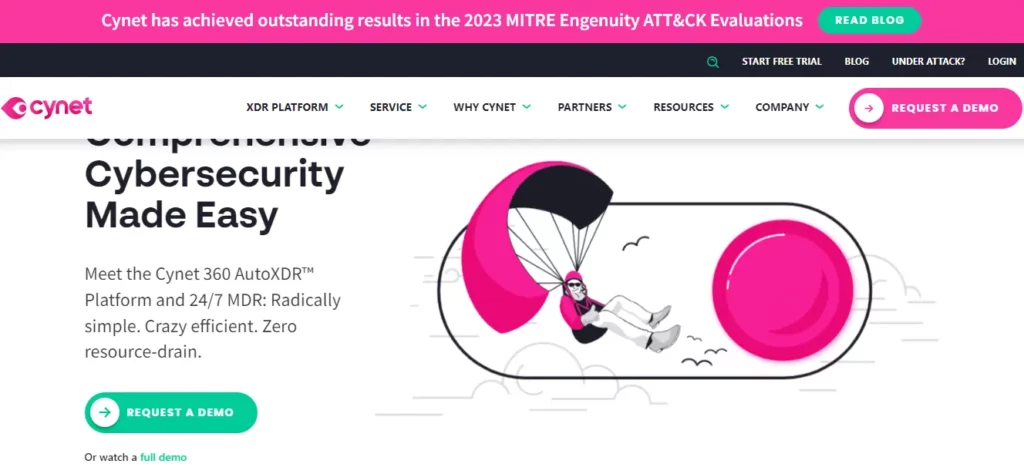
Cynet is a cybersecurity powerhouse that has been making waves since its inception in 2015. Cynet’s primary offering is the Cynet 360 platform, an all-in-one breach protection solution that leverages artificial intelligence and automation to provide comprehensive security.
The platform was purpose-built to enable lean IT security teams to easily achieve comprehensive, effective protection. It supports various deployment models, including SaaS, IaaS, hybrid, and on-premises, making it a versatile choice for organizations with diverse needs.
Cynet’s commitment to innovation in cybersecurity is evident in its significant Series C funding of $40 million, which underscores the industry’s confidence in its vision and solutions.
What does Cynet do?
Cynet stands at the forefront of cybersecurity with its AutoXDR™ platform, which simplifies the complex landscape of cyber threats. The platform is a convergence of essential cybersecurity technologies that empower enterprises to manage vulnerabilities, threat intelligence, and endpoint security within a unified system.
Cynet’s approach is to provide end-to-end protection across an organization’s environment, integrating prevention, detection, and operational capabilities natively. This integration is crucial for organizations seeking to streamline their security operations and ensure robust defense mechanisms against an ever-evolving threat landscape.
By harnessing the power of AI, Cynet’s platform can analyze user behavior, detect anomalies, and respond to incidents with precision, minimizing the risk of breaches and enhancing the overall security posture of enterprises.
Key Features of Cynet
1. AutoXDR™
AutoXDR™ is Cynet’s answer to the complex cybersecurity challenges faced by organizations. It is a fully automated extended detection and response platform that integrates multiple security layers, including endpoint detection and response (EDR), network analytics, and user behavior analytics. This integration allows for a comprehensive view of an organization’s security posture, enabling rapid detection and response to threats with minimal false positives.
2. CyOps™ MDR Service
Cynet complements its technology with the CyOps™ Managed Detection and Response (MDR) service. This 24/7 service provides monitoring, investigation, and incident response, leveraging the expertise of seasoned threat analysts and security researchers. CyOps™ ensures that customers receive tailored support and threat intelligence, enhancing the overall effectiveness of the AutoXDR™ platform.
3. Protector™ Component
The Protector™ component within Cynet’s platform combines several prevention and detection capabilities. It offers multi-layer protection out of the box, saving teams from the hassle of integrating multiple third-party solutions. This component is a testament to Cynet’s commitment to providing seamless and comprehensive security operations.
- Comprehensive breach protection with AI and automation
- Supports various deployments including SaaS, IaaS, hybrid, and on-premises
- Integrated 24/7 CyOps™ MDR service for enhanced support
- Multi-layer protection with the Protector™ component
- User-friendly platform with minimal false positives
- Some instances of ransomware may outpace detection capabilities
- May require a learning curve for the full utilization of advanced features
- Limited third-party integration in certain packages
- Potential for complexity with multiple integrated technologies
5. SparkCognition
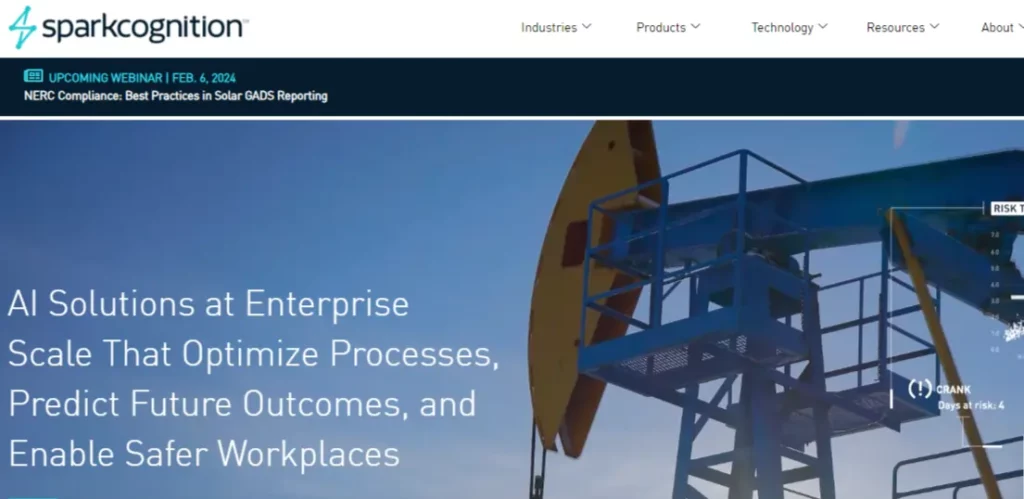
SparkCognition is one of the best artificial intelligence (AI) solutions providers, specializing in AI security tools that address core infrastructure challenges, including asset optimization and preventing zero-day cyberattacks.
The company’s AI platform integrates a comprehensive set of proprietary advancements, such as machine learning, natural language processing, knowledge representation, generative AI, and computer vision, to deliver actionable insights from diverse data sources.
With the motto “AI Perfected for Business™,” SparkCognition has established itself as a pivotal player in the AI domain, offering the best AI security solutions that address some of the most pressing challenges faced by businesses today.
What does SparkCognition do?
SparkCognition excels in operationalizing artificial intelligence to tackle core infrastructure challenges such as asset optimization, zero-day cyberattack prevention, skill gap augmentation, and more.
SparkCognition offers a key AI security tool called the Visual AI Advisor, which transforms existing security cameras into a proactive intelligence platform. This tool can detect and analyze objects in video feeds, thereby reducing accidents, strengthening security, and providing a better understanding of business operations. Another significant tool is the Generative AI Suite, which leverages domain-specific models and internal data sources to enhance security and productivity.
These AI security tools continually improve and provide better results than traditional approaches, making SparkCognition a trusted partner for businesses seeking to leverage AI for security and operational excellence.
Let’s look at some of its key solution areas including:
In addition to products, SparkCognition also offers professional services to help organizations build custom AI solutions.
Key Features of SparkCognition
1. AI-Based Endpoint Protection
One of SparkCognition’s key offerings in the field of AI security tools is its AI-based endpoint protection solution, DeepArmor. DeepArmor uses machine learning to detect and prevent advanced threats, providing a lightweight solution that can protect a wide range of endpoints, from IT to OT assets. It’s designed to prevent 99.9% of zero-day threats, providing anomalous detection protection 24/7.
2. Visual AI Advisor
SparkCognition’s Visual AI Advisor is another significant tool in its AI security portfolio. This solution supports more than 125 end-to-end use cases to improve safety, security, visual inspection, productivity, and situational awareness. It can be paired with any camera system already installed on your site, including CCTV, PTZ, drones, and mobile devices. The Visual AI Advisor can automate visual analytics on multiple real-time video streams at once, providing real-time alerts for various safety and security scenarios.
3. Generative AI Suite
The Generative AI Suite is a hyper-personalized, multi-modal generative AI tool that leverages domain-specific models and internal data sources to enhance workflows and accelerate insights. It’s designed to drive context-rich insights, imbue transparency and explainability into stacked workflows, and spread automated intelligence across organizations.
4. Industrial AI Suite
The Industrial AI Suite is a comprehensive solution that enables manufacturers to leverage explainable AI workflows to minimize downtime incidents, improve yield and quality, reduce maintenance and operational costs, and improve visibility and productivity for their workforce. It has been used in various industries, including manufacturing, oil and gas, and renewables, to predict and prevent operational issues, maximize asset performance, and drive operational efficiency.
- AI solutions address core infrastructure challenges
- Dynamic adaptation to changing threats
- Proactive monitoring with Visual AI Advisor
- Automated model building with ML Studio
- Intelligent interpretation of user inputs with GPT
- Solutions can be complex to integrate and require significant data science expertise
- Some users report a lack of communication
- Lacks industry-specific pre-built solutions, requiring customization
6. CloudSEK

CloudSEK, an AI-based cybersecurity system that leverages contextual AI to predict and prevent cyber threats. With a focus on ensuring the safety and security of organizations, CloudSEK has developed advanced AI Security Tools that provide comprehensive protection against digital risks.
The company’s innovative approach combines the power of Cyber, Brand, and Attack Surface monitoring to give context to digital threats. CloudSEK’s solutions are designed to be highly automated, enabling businesses to detect and stall data breaches, thereby enhancing digital security implementations.
What does CloudSEK do?
CloudSEK leverages artificial intelligence to predict and prevent cyber threats. It offers a suite of products powered by its no-code platform, which uses predictive threat analytics to provide digital risk protection. CloudSEK’s primary product, XVigil, uses a Contextual AI engine for Cyber Threat Intelligence and Attack Surface Monitoring. It monitors multiple attack surfaces and comprehensively fingerprints an organization’s digital assets, scanning both freely available and premium sources to provide deep and dark web coverage.
This AI Security tool’s services include comprehensive data leak monitoring to prevent the leak of sensitive information like code repositories, documents, credentials, and debit/credit card details. It also comprehensively monitors an organization’s infrastructure, including web apps and asset inventory, and detects vulnerabilities and misconfigurations.
CloudSEK’s proprietary model, ThreatMeter, uses artificial intelligence to detect and rate threats accurately in real-time. The threats are then verified in detail, and the dashboard provides analytics that aid in providing insightful and actionable information.
CloudSEK also offers end-to-end management of takedowns, including submission, follow-ups, and confirmation. This feature empowers the security team to make better decisions and eliminates the arduous and manual process of managing takedowns.
In addition, CloudSEK supports integrations with the most widely used solutions, enabling organizations to strengthen their security framework. Its integration mechanism is a set of APIs that customers can use to integrate their Initial Access Vector (IAV). This allows for automatic resolution and remediation of threats.
Key Features of CloudSEK
1. End-to-End Management of Takedowns
CloudSEK offers end-to-end management of takedowns, including submission, follow-ups, and confirmation. This feature empowers the security team to make better decisions and eliminates the arduous and manual process of managing takedowns. The in-house takedowns team assists with takedowns of several brand abuse incidents, including fake social media accounts, unofficial apps on third-party app stores, and DMCA takedowns.
2. Detailed Reports
CloudSEK provides detailed reports of issues so that they can be understood and fixed across your team. These reports offer an in-depth analysis of the escalating data harvesting scams, extensive illegal trade of lead and PII data, and other cybersecurity threats. The reports are designed to keep organizations informed and ahead in cybersecurity.
3. Issue Tracker
CloudSEK’s issue tracker is an all-in-one AI security tool to track, prioritize, and manage potential security issues. This feature ensures that all security issues are promptly addressed and mitigated. The issue tracker can automatically create issues in Jira based on cybersecurity events, allowing for efficient tracking and mitigation of issues.
4. Integration Support
CloudSEK supports integrations with the most widely used solutions, enabling organizations to strengthen their security framework. CloudSEK’s integration mechanism is a set of APIs that customers can use to integrate their Initial Access Vector (IAV). This integration allows for the automatic creation of issues based on cybersecurity events, enabling threats to be resolved and remediated automatically.
5. Comprehensive Asset Tracking and Monitoring
CloudSEK offers comprehensive asset tracking and monitoring, providing a comprehensive list of all assets, including domains, subdomains, and IPs. This feature ensures that all digital assets of an organization are tracked and monitored for potential security threats. CloudSEK’s XVigil platform provides visibility to the organization’s exposed Infrastructure assets, and the platform also automatically updates the asset inventory as any change is observed.
- Comprehensive asset tracking and monitoring
- Detailed and insightful reports
- Wide range of integrations
- The takedown process is managed from beginning to end
- Proactive threat prediction and prevention
- Possible service disruptions from DDoS attacks targeted at CloudSEK itself
- Frequent product updates could necessitate adjustments and reconfigurations
7. IronNet
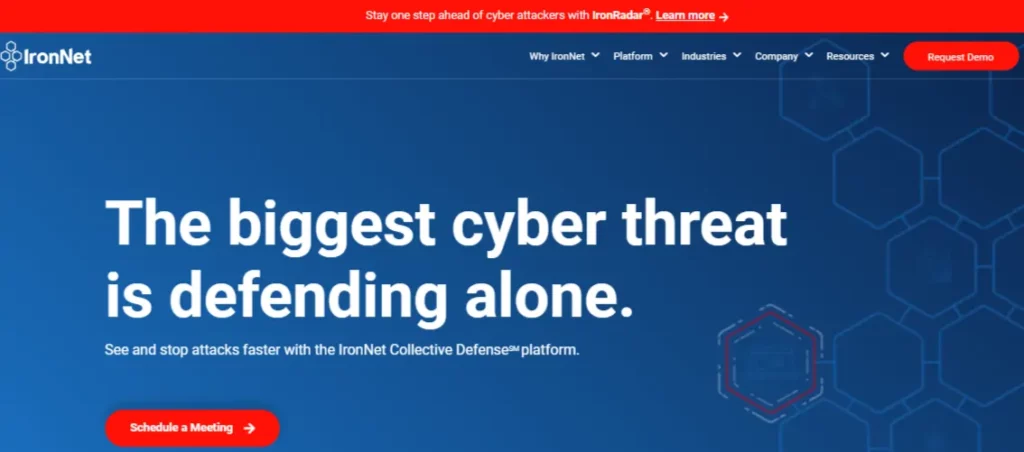
IronNet is a cybersecurity company that provides advanced network detection and response (NDR) solutions powered by artificial intelligence and machine learning to defend organizations against sophisticated cyber threats.
IronNet’s key innovation is its “Collective Defense” approach, which enables anonymous, real-time collaboration between customers to detect emerging threats across industries. By correlating security alerts and attack data across customers, IronNet can identify industry-wide attack patterns and campaigns that would be difficult for any single organization to detect on its own.
The company markets its solutions to enterprises, critical infrastructure providers, and governments worldwide. IronNet has received cybersecurity industry recognition for its innovative technology and has partnerships with major tech companies like Microsoft Azure.
What does IronNet do?
IronNet is transforming cybersecurity with its Collective Defense approach. By applying advanced algorithms, behavioral analytics, and machine learning techniques, IronNet can identify suspicious and potentially malicious activity in a company network for faster threat detection.
Basically, IronNet offers two main cybersecurity products focused on network detection and response:
IronDefense – An on-premise or cloud-based network detection and response solution driven by advanced behavioral analytics and machine learning. It analyzes network traffic metadata to detect known and unknown threats, prioritize alerts, and enable rapid incident response. Key capabilities include real-time detection, threat hunting, alert triage, investigation tools, and integrations with SIEM, SOAR, and other security tools.
IronDome – A cloud-based collective defense solution that allows anonymous sharing of threat intelligence between customers in the same industry sector. By correlating security alerts across customers, it can identify industry-specific attacks and campaigns that would be difficult to detect for any single company. This shared visibility enables faster threat detection and response across the collective.
Together, IronNet’s solutions aim to improve threat visibility, streamline security operations, and enable more proactive defense – both individually and collectively across organizations.
Key Features of IronNet
1. Collective Defense Platform
IronNet’s Collective Defense Platform leverages advanced AI-driven Network Detection and Response (NDR). The platform analyzes threat detections across the community to identify broad attack patterns, providing all members with early insight into potential incoming attacks.
This platform acts as a Security Operations Center (SOC) multiplier, enabling community members to work through alerts more quickly and have enough time to hunt and investigate threats. The Collective Defense Platform is designed to confirm that enterprise networks are safe from cyber-attacks with its automated alert correlation.
2. IronRadar Threat Intel Feed
IronRadar is a purpose-built threat intelligence feed that enables cybersecurity teams to proactively detect malicious command and control (C2) servers before an attack is initiated. IronNet tracks the creation of new malicious infrastructure for numerous post-exploitation toolkits, vulnerability scanners, and remote access trojans (RATs) through a unique fingerprinting process developed by their analysts.
After fingerprinting, the data is enriched with context into purpose-built intelligence updates for proactively blocking the threats. This block-and-tackle capability using IronRadar threat detection and response integrates directly with security tools, enabling teams to quickly detect C2 servers.
3. Enhanced Visibility and Detection
IronNet’s Enhanced Visibility and Detection feature is part of its IronDefense NDR tool. This feature improves visibility across the threat landscape while amplifying detection efficacy within your network environment. IronDefense works with the IronDome Collective Defense solution to deliver dynamic, real-time visibility to threats targeting your supply chain, industry, or region. It enables advanced and early visibility of unknown cyber threats that have slipped past traditional cybersecurity solutions’ defenses, whether on-premises or in the cloud.
4. IronDefense
IronDefense is IronNet’s advanced Network Detection and Response (NDR) solution. It is a highly scalable platform that leverages advanced behavioral analysis to detect threats missed by traditional defenses. IronDefense is the only NDR platform that enables real-time attack intelligence and exchange. It works in conjunction with IronDome Collective Defense solution to deliver dynamic, real-time visibility to threats. IronDefense also reduces false positives through automated alert correlation, including malicious payload detection.
- Innovative collective defense approach improves threat detection
- Advanced behavioral analytics and machine learning detect unknown threats
- Integrates with existing security tools to enhance defenses
- Intuitive interface and investigation tools increase analyst productivity
- Ingesting massive data volumes is necessary to maximize value from advanced analytics
8. Cylance
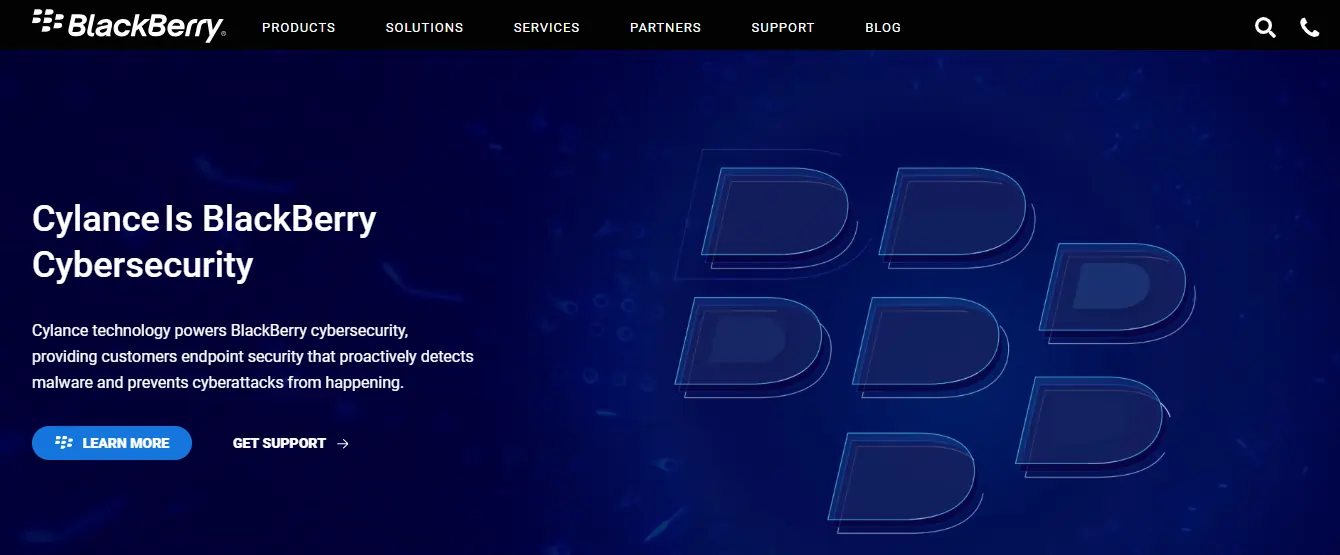
Cylance, a subsidiary of BlackBerry, is a significant player in the domain of enterprise cybersecurity. Based in Irvine, California, the company is renowned for its innovative approach to cyber threat detection and prevention. Cylance has built the largest native AI platform in the industry, which now powers a range of solutions from enterprise endpoint detection and response (EDR) to smart antivirus for consumers and OEM solutions.
The company’s AI-driven security tools are designed to proactively detect and prevent cyberattacks, offering a robust defense against the increasingly sophisticated threats that modern businesses face.
What does Cylance do?
Cylance provides a comprehensive suite of AI Security Tools designed to protect endpoints from cyber threats. Its flagship product, CylanceENDPOINT, is a self-defending, operationally efficient endpoint protection platform that simplifies investigation and response. It uses advanced AI to detect threats before they cause damage, offering powerful protection for a wide range of devices, including Windows, Mac, Linux, Android, and iOS.
Cylance’s solutions are not just limited to endpoint protection; they also include threat intelligence services, providing expertly crafted and customized cyber threat intelligence relevant to your organization. Its products have been recognized with numerous industry awards, reflecting their effectiveness and the high regard in which they are held.
Key Features of Cylance
1. Detect File Behavior and Quarantine Malicious Files
Cylance’s AI-backed security tools are designed to detect and quarantine unsafe and abnormal files. The system groups threat alerts using a Cylance score for the threat, simplifying actions like automatically adding unsafe and abnormal files to a quarantine list. This feature helps to prevent the spread of malware and other cyber threats within an organization’s network.
2. Block Threats from USB Storage Devices
Cylance provides a feature known as Device Control, which protects devices by controlling USB mass storage devices connecting to devices in the organization. When enabled, it can allow full access, read-only, or block USB mass storage devices, such as USB flash drives, external hard drives, and smartphones. This feature is crucial in preventing unauthorized data transfer and potential malware infections from external storage devices.
3. Protect Against Memory Exploits
Cylance’s Memory Protection feature scans and monitors running processes to protect devices from malware that attempts to take advantage of software vulnerabilities. If an application attempts to call a memory violation process, the agent will block the process call, providing an additional layer of security against sophisticated cyber threats.
4. Detect Inactive Devices
Cylance’s Device Lifecycle Management feature allows administrators to specify the number of days (7 to 180) that a device must be inactive before it is automatically marked as such. This feature helps in managing the lifecycle of devices within an organization, ensuring that unused or abandoned devices do not pose a security risk.
5. Protect Virtual Machines
Cylance’s AI security tools are also designed to protect virtual machines. The system’s AI-driven threat detection and response capabilities can be applied to virtual environments, providing the same level of protection as physical devices. This is particularly important for organizations that rely on virtualization for their IT infrastructure.
- Proactive AI-driven advanced threat detection and prevention
- Lightweight client with minimal system resource usage
- Broad operating system compatibility
- Autonomous alert grouping and prioritization
- Advanced threat protection capabilities with CylanceOPTICS and CylanceGATEWAY
- Maybe restrictive if not properly tuned
- Limited to AI-based detection, lacking traditional signature-based methods
- May require additional configuration for optimal performance
9. Balbix

Balbix is a ground-breaking AI-based security solution that provides organizations with unmatched visibility into their attack surface and security vulnerabilities. It uses specialized AI algorithms to continuously analyze over 100 billion signals across the enterprise IT environment to discover assets, identify vulnerabilities, model breach risk, and predict cyberattacks.
Balbix consolidates and correlates data from existing security and IT tools to build a unified cyber risk posture view. It quantifies breach likelihood and potential business impact at the asset level to enable risk-based decision-making. The platform prescribes prioritized actions to fix issues and reduce risk.
It also enables CISOs to demonstrate the effectiveness of security programs and investments to boards and executives using financial risk metrics. With an intuitive user interface and simple deployment, Balbix accelerates security teams’ efficiency by 10x. Leading global enterprises such as Mastercard, Panasonic Avionics, and Par Pacific rely on Balbix as the brains of their cybersecurity operations.
What does Balbix do?
Balbix serves as a force multiplier for security teams by automating manual processes. Key capabilities include automatic and continuous discovery of all assets across on-premise, multi-cloud, and hybrid environments. It ingests and correlates data from existing security and IT tools to build a unified cyber risk posture view. Specialized AI algorithms predict breach likelihood at the asset level based on vulnerabilities, threats, and business criticality.
Additionally, Balbix quantifies cyber risk exposure in monetary terms using the FAIR framework to enable risk-based decision-making. It also prescribes mitigation actions tailored to the organization’s technology stack to reduce risk. With intuitive dashboards, Balbix enables security teams to demonstrate program effectiveness to leadership using financial risk metrics.
By unifying visibility, quantifying risk, and prescribing prioritized actions, Balbix transforms security posture within 90 days. It allows teams to make data-driven decisions to reduce the attack surface and risk exposure.
Key Features of Balbix
1. Comprehensive Visibility
Balbix provides comprehensive visibility on all types of assets, including BYOD, IoT, cloud, and third-party assets. It offers automatic discovery and inventorying of all IT assets, applications, and users, providing a complete picture of an organization’s cybersecurity posture.
2. Real-Time Monitoring
The platform offers continuous and real-time monitoring of all assets across all attack vectors. This feature allows organizations to stay ahead of potential threats and vulnerabilities, ensuring a proactive approach to cybersecurity.
3. AI-Powered Analysis
Balbix uses specialized AI algorithms to analyze the enterprise attack surface and predict likely breach scenarios. It provides a prioritized set of actions that organizations can take to transform their cybersecurity posture, making security teams more efficient.
4. Risk-Based Vulnerability Management
Balbix’s platform provides a prioritized list of security actions based on a comprehensive business risk assessment. It prescribes fixes to address vulnerabilities and reduce risk, helping organizations focus their remediation efforts on the greatest risks.
- Unifies visibility across all security tools with centralized data ingestion and correlation
- Reduces attack surface and risk exposure using predictive AI capabilities
- Quantifies cyber risks in financial terms to report effectiveness to executives
- Prioritizes highest risk vulnerabilities for patching aligned to business criticality
- Correlates vulnerabilities with threats for probability-based risk analysis
- Significantly accelerates vulnerability management and risk reduction
- Requires deployment of network sensors for maximum visibility
- AI models need sufficient data to make accurate predictions
- Dedicated staff needed to configure connectors and tune algorithms
- Lacks native orchestration and automation capabilities
10. CyberRiskAI
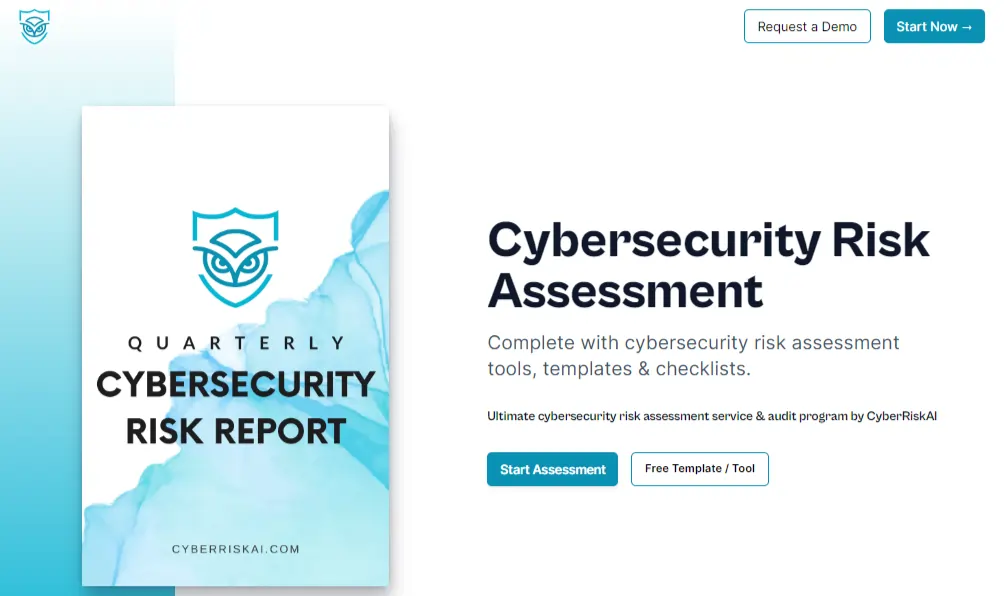
CyberRiskAI is a state-of-the-art cybersecurity risk assessment and auditing tool powered by artificial intelligence (AI). It provides businesses with a fast, accurate, and affordable service to identify and mitigate their cybersecurity risks. This AI security software is equipped with interview templates and checklists to streamline the assessment process, making it a unique and efficient solution in the AI security tools industry.
With CyberRiskAI, companies can embark on their cybersecurity audit journey with confidence with the aid of specialized workbooks and reports. The tool simplifies the complex process of cybersecurity risk assessment, making it more accessible and manageable.
It takes just a couple of minutes to sign up and gain access to a range of risk templates and tools available in various formats like Excel, Word, and PDF. CyberRiskAI’s approach to cybersecurity risk management is not just about identifying risks but also about understanding the likelihood of these risks materializing and formulating strategies to mitigate them.
What does CyberRiskAI do?
CyberRiskAI automates the process of conducting regular cybersecurity risk audits, providing businesses with valuable insights to identify potential vulnerabilities all powered by advanced AI algorithms. It is designed to assist businesses in enhancing their cybersecurity posture by providing a fast, accurate, and cost-effective service.
The platform facilitates the audit process by offering a suite of tools, including customizable templates and checklists, which guide users through the necessary steps to conduct a thorough evaluation of their cybersecurity risks. The service culminates in the generation of a detailed Cybersecurity Risk Assessment Report, which is based on established standards such as NIST or ISO 27001. This report provides businesses with a clear understanding of their cybersecurity vulnerabilities, the likelihood of these risks occurring, and actionable recommendations for risk mitigation.
CyberRiskAI’s AI-driven assessments are instrumental in helping organizations prioritize their security efforts, thereby enabling them to better protect their sensitive data and build trust with their customers and partners.
Key Features of CyberRiskAI
1. AI-Powered Risk Assessments
CyberRiskAI leverages the power of artificial intelligence to conduct comprehensive risk assessments. The AI algorithms analyze a vast array of data points to identify potential vulnerabilities and threats. This AI-driven approach ensures a high level of accuracy and speed, enabling businesses to quickly understand their cybersecurity posture and take necessary actions to mitigate identified risks.
2. Compliance Workbooks
CyberRiskAI provides specialized workbooks for NIST 800-171 and ISO/IEC 27001 compliance. These workbooks guide businesses through the process of achieving compliance with these globally recognized cybersecurity standards. They include detailed instructions, checklists, and templates, making it easier for businesses to understand and meet the requirements of these standards.
3. User-Friendly Interface
The platform features a user-friendly interface that simplifies the process of conducting cybersecurity risk assessments. It allows users to easily navigate through the various features and tools, making the platform accessible to businesses of all sizes and technical capabilities. This ease of use ensures that businesses can effectively utilize the platform to enhance their cybersecurity posture.
4. Customizable Templates and Checklists
CyberRiskAI offers customizable templates and checklists that guide businesses through the process of conducting a thorough cybersecurity risk assessment. These tools ensure consistency in the assessment process and help businesses identify all potential vulnerabilities. The templates and checklists can be tailored to meet the unique needs of each business, ensuring a comprehensive and relevant assessment.
5. Continuous Risk Evaluation
The platform provides continuous risk evaluation, ensuring that businesses can maintain an up-to-date understanding of their cybersecurity risks. This feature is crucial in the rapidly evolving landscape of cyber threats, where new vulnerabilities can emerge at any time. By providing continuous risk evaluation, CyberRiskAI enables businesses to quickly respond to emerging threats and enhance their cybersecurity defenses.
- Provides fast, accurate, and affordable cybersecurity risk assessments
- Utilizes the globally recognized NIST cybersecurity audit framework
- Offers automated quarterly audits, ensuring up-to-date assessments
- Produces comprehensive risk assessment reports
- Uses AI-powered analysis for accurate insights
- The automated nature of the tool may not capture all nuances of a company’s specific risk profile
- The tool’s focus on NIST and ISO 27001 may not cover all compliance needs for businesses operating under different regulations
- The tool may not integrate seamlessly with other cybersecurity tools
11. Deep Instinct
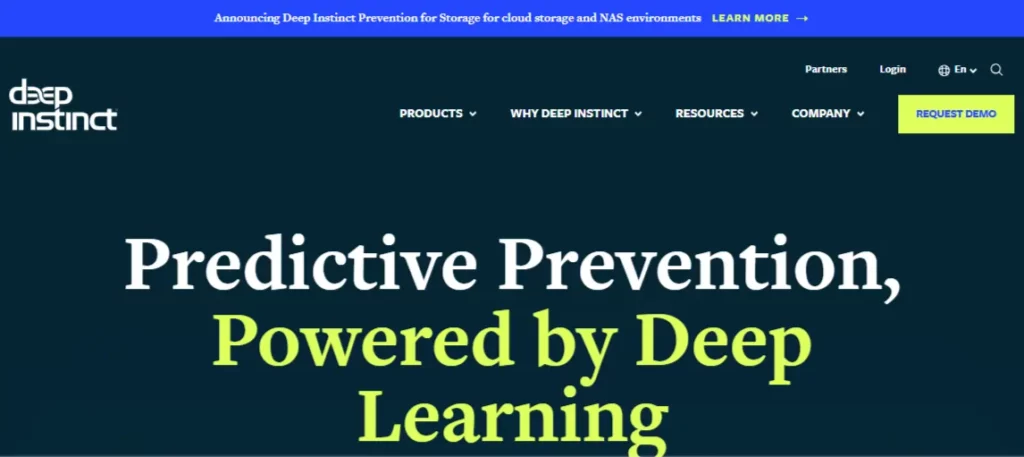
Deep Instinct is a pioneering cybersecurity company that leverages the power of deep learning, an advanced subset of artificial intelligence (AI), to provide comprehensive security solutions. Founded on the premise that deep learning could revolutionize cybersecurity, Deep Instinct has developed a unique, prevention-first approach to combat cyber threats.
The company’s deep learning framework, built exclusively for cybersecurity, is designed to predict and prevent known, unknown, and zero-day threats with unparalleled speed and accuracy.
With over $100 million in funding from top investors like Millennium New Horizons and NVIDIA, Deep Instinct is led by an experienced team including CEO Lane Bess, former CEO of Palo Alto Networks. Deep Instinct takes a unique prevention-first approach to stopping ransomware attacks, malware, and other cyberattacks before they happen.
What does Deep Instinct do?
Deep Instinct provides a multi-layered security solution that expands the possibilities of cybersecurity. It uses a deep learning framework to proactively and predictively secure endpoints, servers, and mobile devices. The company’s unique deep learning (DL) framework, known as the Deep Instinct Prevention Platform, is designed to stop ransomware, known and unknown threats, and malware from reaching data and executing within the environment.
The Deep Instinct platform works by analyzing files and network traffic to predict and prevent both known and never-before-seen threats in real time. It can classify threats in less than 20 milliseconds with over 99% accuracy and less than a 0.1% false positive rate. This allows it to stop ransomware and malware before encryption or damage.
Deep Instinct requires no updates or connectivity to provide autonomous prevention offline using deep learning models. It seamlessly integrates with existing security stacks like SIEMs and SOARs. The Deep Instinct platform provides visibility with dashboards and reports for security teams.
Key Features of Deep Instinct
1. Proactive Prevention
Deep Instinct’s proactive prevention feature is designed to stop threats before they infiltrate the system. It uses a deep learning framework to predict and prevent unknown malware and zero-day threats. This feature is powered by Deep Instinct’s unique DL framework, which integrates seamlessly into various environments, providing unmatched efficacy, accuracy, and scalability. This allows Deep Instinct to stop ransomware, malware, exploits, file-less attacks, weaponized documents, and injected threats before any damage or encryption can occur
2. Automated Static Analysis
Deep Instinct’s automated static analysis is based on raw data, allowing for broad protection against cyber attacks on the widest variety of threats and file types without human intervention. This feature reduces false positives, boosts security team efficiency, and provides near-perfect detection rates.
3. Broad Protection
The Deep Instinct platform provides broad protection across endpoints, servers, cloud workloads, mobile devices, networks, files, and web traffic. It supports securing Windows, macOS, Linux, Android, iOS, ChromeOS, and other operating systems. The lightweight Deep Instinct agent can be quickly deployed to any device or workload to provide advanced threat prevention with minimal performance impact.
4. Autonomous Operation
A key advantage of Deep Instinct is it does not require any updates, cloud connectivity, or human intelligence to prevent threats in real-time. The deep learning models provide offline autonomous threat prevention using predictive capabilities. This allows Deep Instinct to stop threats anywhere, even on air-gapped systems without internet access. The models only require infrequent updates to maintain optimal efficacy.
5. Seamless Integration
Deep Instinct integrates with existing security stacks like SIEMs, SOARs, sandboxes, and ticketing systems via APIs and syslog. This allows automation, orchestration, detection, investigation, and response workflows to function seamlessly with Deep Instinct providing the predictive prevention layer. The platform provides dashboards, alerts, and reports to give security teams visibility into prevented threats.
- Prevents >99% of known and unknown threats with best-in-class accuracy
- Stops threats in real-time in <20 milliseconds before any damage
- Less than 0.1% false positive rate compared to competing solutions
- Easy deployment of agent-based or agentless solutions
- Significantly reduces alerts and saves the security team time
- Currently lacks advanced investigation capabilities beyond prevention
- Requires some security stack integration for automated response
12. Tessian
Tessian is a cutting-edge AI security service company that has carved a niche for itself in the domain of AI security tools. Founded with the mission to secure the human layer within organizations, Tessian leverages machine learning, and artificial intelligence to protect against advanced threats and data loss via email.
Tessian’s innovative approach focuses on understanding human behavior to preemptively identify and mitigate potential security incidents. This human-centric strategy is a departure from traditional rule-based security measures, positioning Tessian as a pioneer in intelligent, adaptive email security solutions.
What does Tessian do?
Tessian’s platform is a fortress against the multifaceted threats that modern enterprises face in their email environments. By integrating seamlessly with email providers like Microsoft 365 and Google Workspace through native API integrations, Tessian deploys within minutes, offering immediate protection without disrupting the workflow of end-users.
The platform’s AI-driven engine analyzes behavioral, content, and threat network data to detect and prevent a wide array of email attacks, including phishing attacks, insider attacks, business email compromise (BEC), and account takeovers (ATO).
Tessian’s ensemble of machine learning models, including deep learning, natural language processing, and anomaly detection, learns individual communication patterns and data handling behaviors. This enables the system to identify anomalies and intervene with real-time, in-the-moment coaching to educate users about potential threats.
The result is a smarter defense against phishing, stronger data protection, and a faster response to incidents, all while fostering a culture of security awareness within the organization.
Key Features of Tessian
1. Tessian Defender
Tessian Defender is an AI-powered feature that automatically shields organizations from sophisticated email threats or malicious activities that traditional security measures might miss. It utilizes machine learning to understand normal communication patterns and can detect anomalies that signal potential threats, such as spear phishing or other targeted attacks.
2. Tessian Enforcer
Tessian Enforcer tackles the issue of data exfiltration by monitoring for unusual data movement or attempts to send sensitive information outside the company network. It alerts users and security teams about suspicious activities, helping to prevent data breaches before they occur.
3. Tessian Guardian
Tessian Guardian is designed to prevent accidental data loss due to misdirected emails. By analyzing email content and recipient details, it can alert users when they are about to send sensitive information to the wrong person, thus averting potential data leaks.
4. Tessian Constructor
Tessian Constructor allows for the customization of security features to meet specific organizational needs. It provides the flexibility to build and enforce policies that are tailored to the unique risks and compliance requirements of the business.
5. Tessian Human Layer Security Intelligence
This feature provides security leaders with insights into human layer risks, enabling proactive risk reduction strategies. It offers detailed analysis and reporting on security incidents, helping organizations to understand and improve their security posture over time.
- Easy and fast deployment with email providers via API
- Requires zero configuration or rules
- Stops advanced threats missed by legacy tools
- Prevents accidental data loss from misdirected emails
- Provides intelligent in-the-moment coaching for employees
- Significantly reduces false positives
- Easy-to-use incident response toolkit for administrators
- Currently only focuses on email security
- Limited native DLP functionality
- Lacks archiving and eDiscovery capabilities
- No email encryption features
13. CrowdStrike

CrowdStrike provides cloud-delivered endpoint protection, cloud workload protection, identity protection, and data protection solutions. Founded in 2011, CrowdStrike pioneered the use of cloud-native technology and artificial intelligence to stop breaches. Its flagship product is the CrowdStrike Falcon platform, which leverages real-time indicators of attack, threat intelligence, and enriched telemetry from endpoints to provide next-generation antivirus, endpoint detection and response (EDR), managed threat hunting, IT hygiene, vulnerability management, and threat intelligence services.
With its cloud-native architecture, the CrowdStrike Falcon platform collects and analyzes over 30 billion endpoint-related events per day from millions of sensors to continuously monitor threats. CrowdStrike serves customers globally across industries including financial services, healthcare, retail, energy, government, manufacturing, tech, insurance, transportation, telecom, and education sectors. Key customers of CrowdStrike include over 60 of the Fortune 100 companies.
What does CrowdStrike do?
CrowdStrike provides a comprehensive suite of AI security services and products designed to protect organizations from cyber threats. The company’s offerings encompass a range of cybersecurity needs, including endpoint security, cloud workload protection, identity protection, and threat intelligence.
At the core of CrowdStrike’s services is the CrowdStrike Falcon platform, an advanced cloud-native platform that delivers endpoint protection through a single lightweight agent. This platform is designed to offer real-time visibility and protection against a wide array of cyber threats, including malware, ransomware, and identity-based attacks. It utilizes artificial intelligence (AI) to detect and prevent sophisticated cyberattacks, leveraging machine learning and behavioral analytics to identify and block threats before they can cause harm.
CrowdStrike’s services extend beyond proactive defense mechanisms. This AI security platform also provides incident response and technical assessments to help organizations prepare for and respond to cyber incidents. Their managed detection and response (MDR) services offer 24/7 monitoring and threat hunting, ensuring that any potential breaches are quickly identified and contained.
Additionally, CrowdStrike offers specialized services for various sectors, including healthcare, retail, and the public sector, tailoring their solutions to meet the unique challenges and compliance requirements of these industries. Their services are supported by a robust partner ecosystem, which includes law firms, insurance companies, and managed security service providers (MSSPs), further enhancing their ability to deliver comprehensive cybersecurity solutions.
Key Features of CrowdStrike
1. Cloud-Native Architecture
CrowdStrike Falcon is built on an entirely cloud-native architecture, with all data processing and analytics performed seamlessly in the cloud. This eliminates the need for on-premises hardware and software, enabling rapid deployment, scalability, and immediate time-to-value. The cloud-native architecture receives a constant stream of real-time data from the endpoints, analyzes it using advanced techniques like AI and machine learning, and delivers protection back to the endpoints.
2. Single Lightweight Agent
The CrowdStrike Falcon platform uses a single intelligent lightweight agent to deliver all its capabilities including next-generation antivirus, endpoint detection and response (EDR), managed threat hunting, vulnerability management, and more. By consolidating all these functions into one agent, CrowdStrike is able to eliminate the need for multiple agents. This simplifies deployment and management overhead for security teams. The single agent provides comprehensive visibility and protection capabilities across endpoints.
3. Threat Intelligence
CrowdStrike Falcon has integrated threat intelligence capabilities that allow it to detect new adversary tools, tactics, and procedures in real time. This helps protect organizations proactively against new and emerging threats. The Falcon platform processes over 30 billion security events and enriches them with intelligence from various sources including CrowdStrike’s proprietary databases. This allows even unknown threats and zero-day vulnerabilities to be identified and stopped rapidly.
4. Incident Response Services
In addition to its core Falcon platform capabilities, CrowdStrike offers industry-leading incident response, compromise assessment, and proactive services. The CrowdStrike Services team comprises experienced security professionals who can augment a customer’s cybersecurity team to assist in preparing for, detecting, investigating, and remediating security incidents rapidly. This allows faster containment and recovery from breaches.
- Delivers superior protection against advanced threats and zero-day attacks
- Consolidates multiple products into one cloud-native platform
- Eliminates the need for on-premises hardware and software
- Provides rapid deployment and immediate time-to-value
- Enables faster incident response and containment
- Offers flexibility with different modules and bundles
- Limited customization compared to on-premises solutions
- Advanced capabilities come at a premium price point
- May require integration with existing security infrastructure
14. Sophos
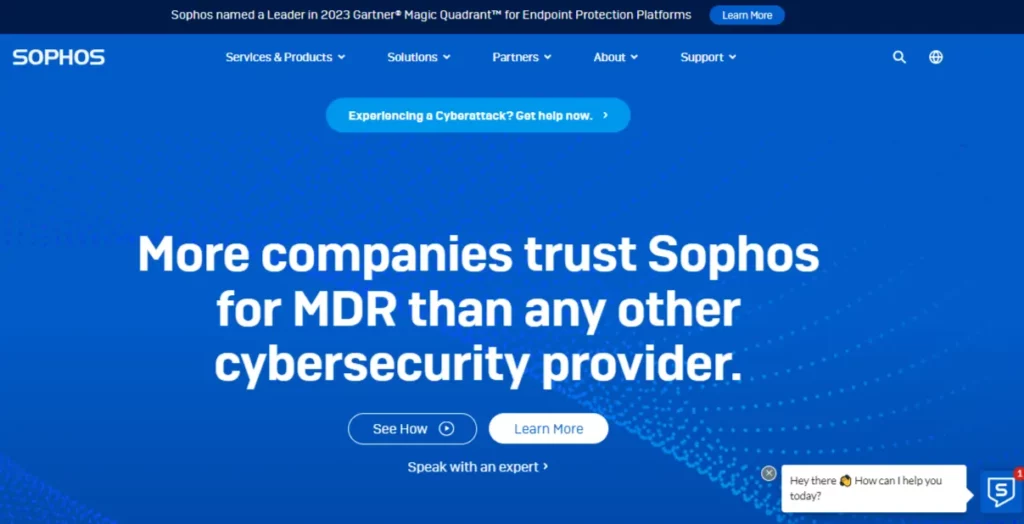
Sophos is a UK-based cybersecurity company founded in 1985 that provides advanced IT security solutions to organizations of all sizes. Its key products include endpoint protection, network security, email security, encryption, managed threat response, cloud security, and more. Sophos serves over 500,000 organizations and 100 million users in over 150 countries.
Sophos offers an integrated cloud-based platform called Sophos Central for managing all its security solutions through a single interface. Its products leverage leading-edge technologies like artificial intelligence, deep learning, and synchronized security to provide real-time threat detection and automated response. Sophos has received numerous industry awards and recognition over the years for its innovative product portfolio. Key differentiators for Sophos include its focus on simplicity, performance, and value along with its vast partner ecosystem.
What does Sophos do?
Sophos is focused on providing advanced cybersecurity solutions across critical IT infrastructure areas to protect organizations against advanced threats and data breaches.
Its key product categories include:
Key Features of Sophos
1. Security Heartbeat
The Security Heartbeat feature is a unique offering from Sophos that connects managed endpoints with firewalls, enabling real-time sharing of health status and threat information. This synchronization allows for an active threat response, where threats are immediately blocked without the need for manual firewall rules. It also facilitates lateral movement protection, preventing attackers from advancing within the network.
2. Synchronized App Control
Sophos’s Synchronized App Control provides unmatched visibility into network applications, even those that are not well-defined within the network. This feature allows for the automatic identification and management of applications, enhancing control and security across the network.
3. Machine Learning Protection
Sophos leverages its industry-leading machine learning technology, powered by SophosLabs Intelix, to identify and block the latest ransomware and unknown threats before they penetrate the network. This proactive approach to threat detection is a cornerstone of Sophos’s advanced cybersecurity measures.
4. Cloud Native Security
Sophos Cloud Native Security offers comprehensive security coverage across various environments, workloads, and identities. It integrates with SIEM and DevOps tools, providing centralized visibility and prioritized detections for faster incident response.
5. Central Management
Sophos provides a centralized management platform that simplifies the administration of security policies and devices. This ease of management is a significant advantage for organizations looking to streamline their security operations.
- Superior protection against advanced threats via synchronization with endpoints
- Intuitive graphical policy creation and management
- Unified cloud-based platform with extensive capabilities
- High-performance next-gen firewall with advanced inspection
- A broad set of network security features (IPS, sandboxing, web/app control, etc.)
- Easy to deploy, manage, and scale
- Additional endpoint license required to enable full synchronization
- Lacks native support for managing third-party network gear
- Reporting is not as extensive as some competitors
15. Dataminr
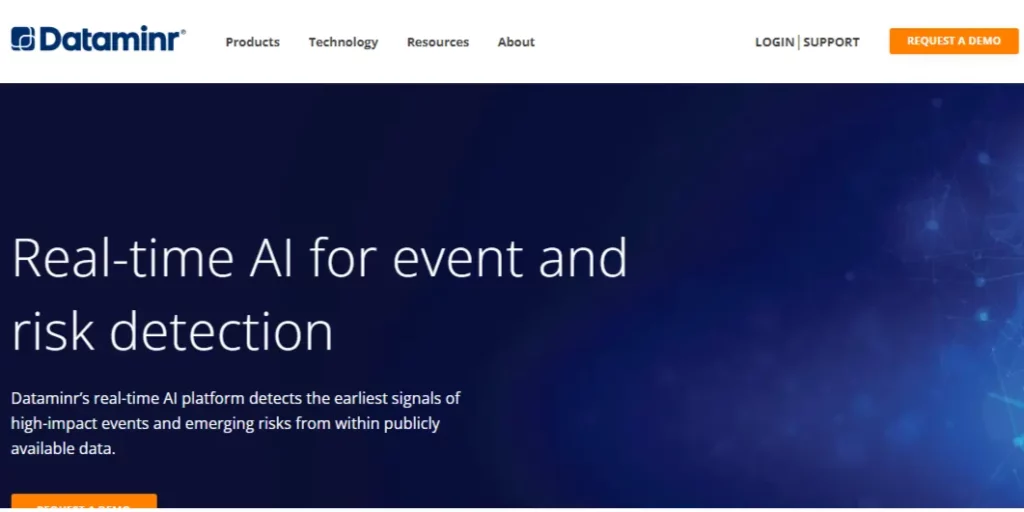
Dataminr stands out as a preeminent AI company, globally recognized for its advanced technologies that provide early warnings of high-impact events and emerging risks. With a clientele that spans over 100 countries, Dataminr has established itself as a critical tool for organizations seeking to stay ahead of potential threats.
Impressively, Dataminr has developed a leading AI platform that analyzes data from over 800,000 public data sources in over 100 languages to identify emerging risks and events in real-time. Dataminr serves clients across the public and private sectors including news organizations, corporations, government agencies, and nonprofits.
Its products include Dataminr Pulse for corporate security and risk management, First Alert for public sector and emergency response, and news alerts for journalists. Dataminr’s impressive growth is reflected in its status as one of New York’s top private AI technology firms. Notably, In 2022, it raised $475 million in funding at a $4.1 billion valuation.
What does Dataminr do?
At a high level, Dataminr uses AI to transform open-source data into real-time notifications to help organizations detect, understand, and respond to risks or events faster. Specifically, Dataminr ingests and analyzes over 799,999 public data sources including social media, news websites, blogs, public datasets, and more.
It applies natural language processing, neural networks, computer vision, and other AI techniques to identify signals that may indicate an emerging event or risk. Once a risk or event is detected, Dataminr sends alerts in real-time to its clients. These alerts contain contextual information to help clients assess the credibility and potential impact of the event. Dataminr also provides collaborative AI tools to manage responses. This includes features like geovisualizations, workflows to standardize response plans across teams, employee safety notifications, and more.
Key Features of Dataminr
1. Real-Time Alerts
Dataminr’s real-time alerts are a cornerstone feature, providing users with immediate notifications about critical events as they unfold. This capability allows organizations to respond quickly, ensuring that they are always one step ahead of potential risks. The platform’s ability to filter out irrelevant information ensures that clients receive only the most pertinent alerts, enabling them to focus on what truly matters.
2. Early Warning Detection
The AI and machine learning algorithms employed by Dataminr analyze billions of data points to detect early warning signals. This sophisticated technology translates content across over 100 languages, ensuring comprehensive coverage and a substantial time advantage for users when responding to crises.
3. Multi-Modal AI Fusion
Dataminr’s multi-modal AI fusion is a unique feature that cross-correlates data from various sources, including text, image, video, sound, and machine-generated sensor data. This approach allows for a more nuanced and comprehensive understanding of events, enhancing the platform’s detection capabilities.
4. Integration with SIEM, SOAR, and TIP
Dataminr Pulse integrates seamlessly with leading Security Information and Event Management (SIEM), Security Orchestration, Automation and Response (SOAR), and Threat Intelligence Platform (TIP) solutions. This integration streamlines the process of managing cyber threats and enables faster detection and mitigation of risks.
5. Comprehensive Risk Management
Dataminr offers an end-to-end solution for risk management, enabling corporate security teams to plan for, manage, and respond to risks and events all in one place. This holistic approach simplifies the complex task of navigating the dynamic risk landscape that businesses face today.
- Provides very early warning of emerging events and risks
- A high degree of accuracy and context in alerts
- Easy integration into existing security and IT workflows
- User-friendly interface and excellent customer support
- Data sources may sometimes lack credibility or validation
- Possibility of false positives or inaccurate alerts
Challenges and Solutions in Implementing AI Security Tool
The path to fully realizing the power of AI for enhanced cybersecurity is paved with obstacles. Despite the tremendous upside, integrating these innovative tools surfaces difficult questions around skills, security, bias, and more.
Let us deep dive into some challenges of implementing AI security tools and solutions to effectively implement these powerful AI tools:
Challenges in Implementing AI Security Tools
1. Lack of Skilled Staff – Managing and maintaining AI systems requires data scientists, ML engineers, and other technical specialists. Many companies face shortages of qualified personnel to support AI security tools.
2. Integration Difficulties – Legacy security infrastructure, complex networks, and siloed data make connecting new AI tools difficult. Extensive customization and professional services are often needed.
3. Justifying Costs – The high upfront costs of AI platforms can be hard to justify, especially when benefits are initially uncertain. Proving return on investment is critical for widespread adoption.
4. Biases and Ethics – AI models can perpetuate biases or make unfair decisions unless properly monitored. Rigorous oversight is essential but adds overhead.
5. Susceptibility to Attacks – Like any software, AI tools have vulnerabilities that hackers can exploit to extract data or manipulate models. Securing AI is extremely challenging.
6. Compliance Risks – Stringent regulations around data privacy, localization, and algorithmic transparency create potential compliance issues when deploying AI globally.
Solutions for Successful AI Security Implementations
Here are the best practices organizations can follow to overcome barriers:
With careful planning, robust security precautions, and an emphasis on ethics, companies can overcome the hurdles involved in harnessing AI tools for enhanced threat detection and response.
Case Studies of AI Security Tools in Action
Through compelling case studies demonstrating AI security solutions’ ability to fortify defenses and outmaneuver threats, the transformative real-world impact of AI security tools like Darktrace, Cylance, and CrowdStrike is evident, enabling organizations to detect and prevent sophisticated cyber-attacks.
Darktrace’s Self-Learning AI autonomously spots subtle anomalies across cloud, network, email, and endpoints, catching zero-day threats early. Its cyber defense platform is deployed by over 7,400 organizations globally. For example, Darktrace enabled the smart city of Las Vegas to fundamentally transform its security posture by providing 24/7 threat monitoring, reducing incident triage time, and allowing the security team to focus on higher-level work.
SSP Worldwide adopted BlackBerry Cylance which uses artificial intelligence to prevent attacks before damage occurs to protect legacy and online systems, preventing up to 99.4% of advanced threats without disruptive false positives.
Another real-world case study shows the ability of the CrowdStrike Falcon platform as the State of Wyoming and over 20,000 organizations worldwide rely on CrowdStrike to protect against today’s sophisticated threats. The CrowdStrike Falcon platform leverages AI and machine learning for next-generation endpoint protection and response. Noticeably, CrowdStrike Falcon Detected and stopped the 2020 SolarWinds supply chain attack within 60 minutes of its launch.
These real-world case studies demonstrate the power and potential of AI in enhancing cybersecurity measures. By leveraging AI, organizations can ensure their digital assets and operations remain secure.
FAQs Related to AI Security Tools
What are the benefits of AI security tools?
Key benefits include faster and more accurate threat detection, increased efficiency through security automation, continuous learning and adaptation, and scalability to handle growing data sources.
What types of AI security tools are available?
Major types include endpoint detection and response, network detection and response, user and entity behavior analytics, security information and event management, intrusion detection/prevention systems, and fraud detection tools.
How is AI transforming cybersecurity audits?
AI is automating parts of audits through data analysis, providing visibility across infrastructure, detecting anomalies, ensuring compliance, and predicting future risks.
Can attackers exploit vulnerabilities in AI security tools?
Yes, AI systems have vulnerabilities that hackers can exploit to extract data, manipulate models, and disable security defenses. Securing AI is extremely challenging.
Does AI pose ethical risks related to security and privacy?
Yes, a lack of transparency in how AI systems make decisions and potential biases can lead to unfair outcomes that harm individuals or groups. Strict governance is essential.
Can AI security tools comply with regulations?
While useful, organizations must assess compliance risks with regulations around data privacy, localization, and algorithmic transparency when deploying AI security globally.
Will AI replace cybersecurity professionals?
No. AI will augment human capabilities, not replace them. Security teams will still be needed to manage AI tools, interpret results, tune systems, and make final decisions.
Are open-source AI security tools available?
Yes, tools like AISEC for intrusion detection, DeepDefense for malware detection, and AI Squared for phishing use open-source libraries like TensorFlow and PyTorch.
How can I get started with AI security in my company?
Conduct a risk assessment to identify gaps, then pilot a commercial or open-source AI solution in a focused, high-risk area rather than attempt full-scale deployment initially.
Final Words on AI Security Tools!
You have come to the end of this comprehensive guide on the top AI security tools available today. It is clear that as AI continues its rapid development, new security risks and vulnerabilities are emerging. However, with the right tools, these risks can be effectively managed.
The 14+ AI security solutions covered provide capabilities like explainability, robustness testing, data and model governance, and continuous monitoring. Leading options like Darktrace, Vectra AI, and SentinelOne enable enterprises to deploy trustworthy and ethical AI systems. As you choose tools for your organization, evaluate them across metrics like model risk management features, integration ease, and customer support availability.
In closing, prioritizing AI safety now is crucial to unlock innovation while avoiding detrimental outcomes down the line. The tools highlighted put the power in your hands to develop AI responsibly.
As the famous quote goes, “With great power comes great responsibility.” So, stay vigilant, and here’s wishing you safe passage into our increasingly intelligent future.
Affiliate Disclosure: This post may contain some affiliate links, which means we may receive a commission if you purchase something that we recommend at no additional cost for you (none whatsoever!)


